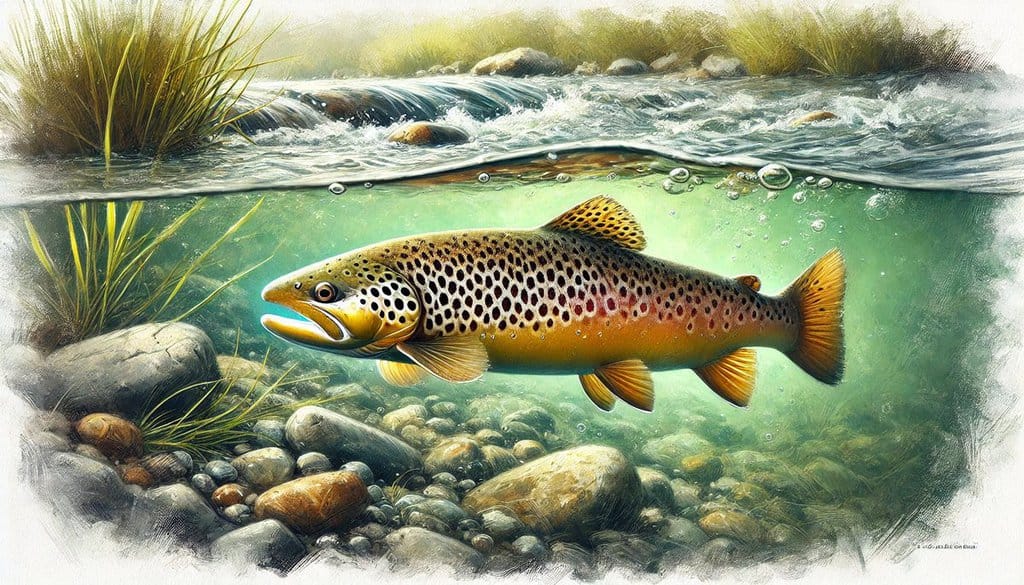Brown Trout (Salmo trutta) is a popular species for aquaponics due to its adaptability and high-quality flesh. Known for its resilience and rapid growth rate, this cold-water fish offers aquaponics enthusiasts an excellent option for both ornamental and food production systems[4].
Natural Habitat and Behavior
Origin and native environment
Brown trout naturally inhabit cold, well-oxygenated rivers and lakes across Europe, North Africa, and western Asia[4].
Natural behavior in the wild
In their natural habitat, brown trout are known for their migratory behavior, with some populations (sea trout) moving between freshwater and marine environments[4].
Temperament
Brown trout can be territorial and may exhibit aggressive behavior towards other fish, especially during breeding seasons[1].
Compatibility
Due to their potentially aggressive nature, it’s best to keep brown trout with their own species or other cold-water fish of similar size[1].
Water Requirements
Temperature Range
- Ideal temperature: 12-16°C (53.6-60.8°F)
- Can tolerate: 0-22°C (32-71.6°F)
- Above 23°C (73.4°F), trout struggle to survive[1][2]
pH Level
- Recommended range: 6.5-8.0
- Stable pH is crucial for trout health[5]
Water hardness
Brown trout prefer moderately hard water, but can adapt to various hardness levels.
Oxygen Levels
- Minimum dissolved oxygen: 5.5 mg/L
- Optimal level: Above 7 mg/L[1]
Ammonia/Nitrate Sensitivity
Trout are sensitive to ammonia and nitrite like most other fish. Keep levels below 0.5 ppm for both. Nitrate should be maintained below 50 ppm[1].
Tank or Pond Setup
Tank/Pond Size Requirements
- Minimum 300-600 gallon (1,136-2,271 liter) tank for 2-3 foot (0.6-0.9 m) trout
- Larger species (4-5 feet / 1.2-1.5 m) require thousands of gallons[5]
Filtration & Aeration
Strong filtration and high aeration are crucial. Trout require fast-flowing water to mimic their natural habitat[1][5].
Lighting Considerations
Natural light cycles are best, but avoid excessive direct sunlight to prevent water temperature increases.
Tank Decorations/Substrate
Include rocks and plants to provide hiding spots and mimic natural environments. Ensure decorations don’t impede water flow[5].
Feeding Requirements
Diet
Brown trout are carnivorous. In aquaponics, use high-quality commercial trout feed[1].
Feeding Techniques
- Feed 2-3 times daily
- Distribute food evenly across the water surface
- Adjust feeding based on water temperature and fish size[5]
Supplements or special diets
Supplement with live food occasionally to mimic natural diet and promote health.
Growth and Reproduction
Growth Rate
Brown trout grow rapidly, reaching 20-30 cm (8-12 inches) in their first year under optimal conditions[4].
Physical Growth Indicators
As they mature, brown trout develop distinctive spotting patterns and may change coloration.
Breeding Behavior
Breeding typically occurs in autumn. In aquaponics, natural breeding is challenging and not commonly practiced.
Care of Fry
If breeding occurs, separate fry to prevent predation. Feed with specialized fry food until they reach fingerling size.
Harvesting & Culinary Considerations
Growth to Harvest
Trout typically reach harvest size of 250-300 g (0.55-0.66 lbs) in 10-12 months[1].
Culinary Uses
Brown trout have a delicate, nutty flavor. They’re excellent grilled, baked, or smoked.
Recommendations for Ethical Harvesting
Use humane methods like rapid chilling or percussion stunning to minimize stress.
Pros and Cons
- Fast growth rate
- High-quality, marketable fish
- Efficient feed conversion ratio
- Require cold water, which may need chilling in warmer climates
- Sensitive to water quality fluctuations
- Higher oxygen requirements compared to some other species[1][2]
Overall Suitability
Best suited for intermediate to advanced aquaponics practitioners in cooler climates or with temperature control systems.
Common Health Issues and Solutions
Potential Diseases
Susceptible to bacterial infections like furunculosis and parasitic infestations.
Signs of Health Issues
Look for loss of appetite, unusual swimming patterns, or visible lesions.
Treatment Recommendations
Maintain excellent water quality. Consult a fish health specialist for specific treatments if issues arise.
Maintenance Tips for Long-Term Health
Maintenance Frequency
Perform weekly water quality tests and daily visual inspections.
System checks
Monitor oxygen levels, temperature, and water quality parameters regularly.
Handling Practices
Minimize handling. When necessary, use wet hands or nets to avoid damaging the fish’s protective slime coat.
Winter/Summer Care
Ensure consistent cool temperatures year-round. In summer, additional cooling may be necessary.
Tank Compatibility and Stocking
Stock at no more than 0.5 kg per 100 L (0.04 lbs per gallon) of water[2].
Closing Thoughts
Brown trout offer a rewarding challenge for aquaponics enthusiasts, particularly those in cooler climates. Their rapid growth and high-quality flesh make them an excellent choice for food production systems. However, their specific water quality and temperature requirements demand careful management and may not be suitable for beginners.
More fish species for aquaponics
External sources:
[1] https://www.youtube.com/watch?v=3ULtyZrOXU4
[2] https://www.howtoaquaponic.com/fish/rainbow-trout-aquaponics/
[3] https://www.mdpi.com/2073-4441/9/1/13
[4] https://www.hi.no/en/hi/temasider/species/brown-trout
[5] https://horticultureadvice.com/how-to-raise-trout-in-aquaponics/
[6] https://www.aquanet.com/trout-aquaculture

